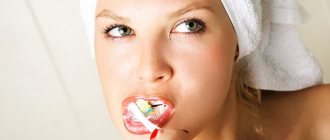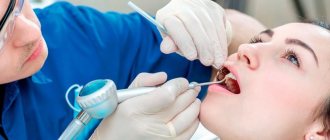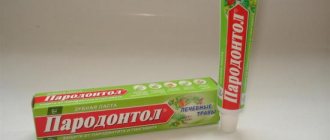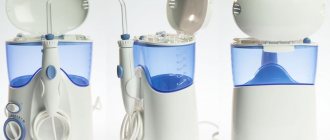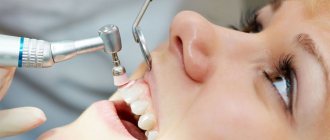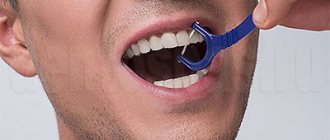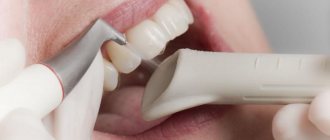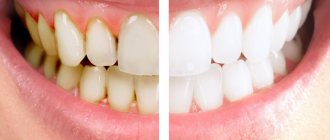A person’s health and the condition of their teeth are influenced by many different factors. Ignoring the rules of oral hygiene leads to dental diseases. True, sometimes even the most painstaking cleansing using premium quality pastes does not help get rid of all problems with oral cavity contamination.
It is common knowledge that you need to have dental cleanings twice a year. This is explained by the fact that even if all the rules of oral hygiene are observed, it is impossible to avoid the appearance of plaque. You can get rid of this phenomenon only in special ways - using ultrasound or using the Air Flow method.
Both of these methods have their merits. However, you need to figure out: what to choose to achieve the best effect? Teeth cleaning with Air Flow or ultrasound: which is better? We'll talk about this in the article.
Choosing a cleaning method and determining the best one
Dental clinics most often use ultrasonic or hardware cleaning (this is Air Flow). Both of these methods give good results, and their prices are in the same range, so it can be quite difficult to make a choice. But since these teeth cleaning methods are a medical procedure, it is necessary to study all aspects of these procedures. Perhaps one of the methods is not suitable due to contraindications or other factors.
Most people think that getting your teeth cleaned at the dentist is a stupid waste of money, but it's not. If plaque remains on the teeth for a long time, sooner or later it will turn into tartar. Due to dental plaque, gum damage can develop - periodontal disease. You can even lose your teeth if you don't worry about hygiene. That’s why you need to have professional cleaning done regularly, and your dentist will always help you decide on the method.
Important! Without consulting a specialist, a person is unlikely to be able to choose the method he needs.
The choice should be based on the individual characteristics of the patient, the health of the oral cavity and the body. After all, cleaning should never cause harm.
Comparative characteristics
The choice between ultrasound and enamel cleansing with a soda-water mixture must be made taking into account the condition of the teeth and gums. If inflammatory processes, periodontal disease or periodontitis occur, it is better to choose the ultrasound method, as it helps solve the described problems. It is also worth opting for ultrasound waves when it comes to significant and old stone deposits - in this case, Air Flow may not cope with the task, and by paying money for the procedure, you will not get the desired effect.
Air Flow is the choice of those who regularly monitor the condition of their teeth and prevent serious deposits of stones. This is a more affordable procedure that is offered in almost every dental clinic.
When should you choose ultrasonic cleaning?
During this procedure, the dentist uses specialized equipment that allows for changing attachments. The size of the nozzle determines the effectiveness of cleaning and is selected based on the scale of dental plaque. Due to vibration effects, tartar is destroyed.
This procedure does not cause pain, so anesthesia is not necessary. This is a definite advantage of ultrasonic cleaning. If the patient still experiences discomfort, the doctor reduces the amplitude and frequency of vibrations. It is almost impossible to injure your gums or teeth during ultrasonic cleaning, which makes it safe.
Teeth cleaning is carried out with an ultrasonic scaler or hook, the tip of which reaches 30-40 thousand vibrations per second. Cleaning takes place quite carefully and carefully, relieving the patient of stone and plaque. Before cleaning, the doctor examines the patient’s oral cavity and determines the presence of contraindications.
Interesting! By the way, the procedure takes very little time.
Features of ultrasonic cleaning, stages of implementation.
- First, the tartar is removed.
- After removing the stone, the tooth is freed from plaque.
- After this, the teeth are covered with a special film that performs protective functions. This will prevent tartar from forming again.
At the first stage, stone is removed from the teeth using ultrasonic vibrations. To do this, the doctor uses a scaler, which very quickly relieves the patient of any type of stone.
At the second stage, the doctor removes plaque. An aerosol containing cleaning powder, air and water washes away plaque and other harmful deposits even from inaccessible places. After the procedure, tooth enamel becomes white and smooth again.
The third stage involves polishing the tooth surface using a special brush and paste, and polishing rubber bands. To improve the cleaning effect, teeth are coated with special products, allowing them to stay clean longer and protecting them from external influences.
Indications and contraindications
Although ultrasonic cleaning is recognized as safe, it has contraindications. So it is necessary to study who can undergo this procedure and who should refrain from it.
Ultrasonic cleaning is needed in the following cases:
- the patient notes an unpleasant odor from the mouth;
- in the presence of plaque and tartar;
- the gums are swollen and bleeding, there are deposits under them;
- when the color of the enamel changes.
All these factors indicate incipient problems with oral health. In fact, there are many more of them, but even with these signs it is better to go to the dentist so as not to worsen the problem. Ultrasound cleaning allows you to avoid many additional procedures, such as prosthetics.
However, there are contraindications for ultrasonic cleaning:
- inflammation in the body;
- viral or infectious diseases;
- chronic disease in the acute stage;
- the patient is a child or teenager;
- increased sensitivity.
Important! Almost all of these factors can be eliminated, so if you get rid of these problems, you can carry out ultrasonic cleaning.
Stages of the procedure
In general, ultrasonic cleaning is carried out in several main stages.
- Examination of the patient’s oral cavity, checking its problem areas, the degree of plaque.
- Numbing problem areas, but numbing them if necessary.
- Skyler. In this case, the device has two operating modes. The procedure is carried out with a thin stream of water or dry. The power of impact is also determined by a specialist.
- Treatment of teeth, grinding them with a drill and a special attachment. They can also be sanded with hand tools.
- Covering each tooth with fluoride-containing gel and varnish. It reduces the sensitivity of the enamel for 2-3 days.
How does Air Flow work?
To clean teeth in this way, a sandblaster is used. Baking soda mixed with an abrasive substance is sprayed under pressure onto the surface of the tooth. Soda particles protect tooth enamel from injury, and tartar is removed due to a special composition. The procedure is carried out quite quickly, and the effect is amazing. It cannot definitely be called the best, since ultrasonic cleaning and cleaning with Air Flow differ in the method of implementation and active substances.
Why should a patient choose Air-Flow cleaning?
- this method is safe and contactless;
- no pain or discomfort;
- tooth enamel is not damaged;
- no vibrations or heating of the tooth;
- this method is an excellent prevention of oral diseases;
- Plaque can be removed even from hard-to-reach areas of the tooth;
- prevention of caries.
Video - Stages of teeth cleaning using the Air Flow method
Stages of the procedure
Air Flow teeth cleaning is carried out in several main stages.
Specialist:
- Covers the patient's lips with Vaseline. This will prevent them from drying out.
- Places a saliva ejector in the patient's mouth. It gets rid of saliva, which is actively released during the procedure.
- Puts a special hat and glasses on the patient. They protect the face and hair from small particles and abrasive powder used when brushing teeth.
- Carefully treats each tooth. It is important that the jet does not hit soft tissues or dentin. With caries and erosion, the patient may experience discomfort.
- Covers treated enamel with a fluorine-containing compound. It consolidates the resulting effect.
Remember: the force of the jet pressure is controlled by the dentist independently.
This is how it controls the force applied to soft and hard deposits. Thanks to this, the procedure becomes more effective. In this case, plaque and food debris are carefully removed, the patient does not feel any pain.
It is also a good prevention of caries.
How to clean with braces?
The presence of braces almost always interferes with comprehensive teeth cleaning, so plaque and various harmful deposits appear around them. Air Flow will help you get rid of these problems. The composition sprayed onto the teeth will effectively rid their surface of dirt.
Important! Bacterial or pigment plaque is a signal that caries may soon develop. In advanced cases of caries, there may be complications such as periodontitis or pulpitis. Then a person risks losing a bad tooth.
Air Flow cleaning helps protect your teeth from such dangerous diseases.
Can Air Flow be used by pregnant women?
Pregnancy may well be a reason to refuse the procedure. This is due to the fact that a pregnant woman has an impaired calcium metabolism in the body, which is why the tooth enamel becomes too sensitive, and Air Flow can injure it. So you should not clean your teeth using this method during pregnancy.
Air Flow cleaning efficiency
The advantage of using the Air Flow device for cleaning teeth is that the result is always the same. In addition, teeth visually look much better, as it is always nice when they return to their original white color. Clients report positive changes in their image as a result of cleaning.
The results of this cleaning:
- pigmented areas no longer bother the patient;
- no more bad breath;
- clean and white tooth enamel;
- aesthetic beauty of teeth;
- healing teeth and enriching them with essential minerals.
Indications and contraindications for Air Flow cleaning
| Indications | Contraindications |
| It is recommended to use Air Flow in the following cases: the patient suffers from various deposits on the teeth; partial darkening of the enamel is observed; need to clean orthodontic structures; for the prevention of various oral diseases. | The use of Air Flow is contraindicated in the following cases: the patient suffers from epilepsy, asthma or bronchitis; with a viral or infectious disease; if there is inflammation in the mouth. |
Contraindications
- Cardiac arrhythmia.
- Bronchial asthma.
- Enamel hyperesthesia.
- The presence of serious diseases - hepatitis, HIV/AIDS, tuberculosis. In these cases, the possibility of carrying out Air Flow cleaning is determined by the doctor on an individual basis.
It would hardly be correct to consider Air Flow a full-fledged method of teeth whitening. First of all, we are talking about removing plaque and stones. However, a thoroughly cleaned enamel surface will in any case become lighter, and your smile will be brighter and more attractive.
Advantages and disadvantages of procedures
Ultrasonic cleaning has the following advantages.
- The procedure is safe because it is non-contact and is carried out without the use of aggressive chemicals.
- It copes well with various types of deposits that cannot be removed by a toothbrush.
- The scaler copes with deposits under the gums.
- Teeth acquire a natural shade.
Interesting! The disadvantages include the impossibility of performing the procedure for people with braces and other structures (prostheses, etc.); cleaning cannot be performed in the first trimester of pregnancy.
Advantages of the Air Flow procedure.
- No pain or discomfort.
- The enamel is protected from injury.
- It is possible to get rid of dental plaque in inaccessible places.
- It is acceptable to perform cleaning on patients with braces, implants and other structures.
Important! At the same time, Air Flow cannot remove hard plaque or deposits under the gums. The procedure does not cope with microbes that cause inflammation in the mouth.
Indications for professional teeth cleaning
There are many indications for professional teeth cleaning, ranging from the banal presence of dental deposits, including tartar, and ending with preparation for dental implantation or other serious dental interventions.
The extremely beneficial effects of teeth cleaning in a dental office determine the popularity and demand for such a service. Remember that regular visits to a dentist for medical examinations and professional cleaning are the key to the health and longevity of your smile!
What should you do after cleaning?
After ultrasonic or Air Flow cleaning, dentists recommend abstaining from certain foods and smoking for several hours. Otherwise, you can damage the enamel or paint it undesirable colors.
You should avoid the following products:
- too hard food;
- food with a high content of dyes (the origin of the dye does not matter);
- sour food;
- tea, coffee, chocolate, wine.
Important! If you ignore these recommendations, pigment plaque will soon form on your teeth. In addition, the enamel becomes more sensitive.
It is worth noting that in the first few days after cleaning, the patient may notice excessive tooth sensitivity, slight pain and bleeding gums. If you follow the dentist's advice, the discomfort will quickly go away.
Recommendations after professional teeth cleaning
To ensure that the results of professional teeth cleaning with ultrasound or the Air-Flow method are as long-lasting as possible, experts recommend adhering to the following rules whenever possible:
- After the procedure, replace your toothbrush, and make it a rule to change it strictly every 3 months.
- It is also recommended, within two days after professional teeth cleaning, to eliminate, if possible, the influence of external factors that contribute to the deterioration of the condition and color of teeth. These include smoking, drinking coffee and tea, other coloring products (berries, ketchup and tomatoes, chocolate and red wine), etc.
- Experts also draw attention to the importance of thoroughly brushing your teeth according to all the rules (twice a day, if necessary, using dental floss and mouthwash, etc.)
- It is recommended to use toothbrushes with soft bristles, due to the fact that even products with a medium degree of hardness often cause “micro-scratches” on the enamel, where plaque subsequently accumulates and easy penetration of pigments occurs, changing the color of the teeth.
- To maintain the health and beauty of your teeth, it is recommended to have your teeth professionally cleaned twice a year.
Questions for doctors
Patient: “Good afternoon, I’m very worried because I made an appointment for cleaning immediately after caries treatment. Will this cause new dental problems? Will the filling be ok? If I have an appointment for braces, can I have the cleaning done the day before? Or when is the best time to do it? Thank you in advance".
Doctor: “Good day!
Dental cleanings should usually be performed before dental treatment to remove plaque. This is explained by the need to remove harmful bacteria. In exceptional cases, teeth affected by caries are first treated, which is what happened in your situation. Cleaning the filling will not harm the filling in any way.
As for braces, cleaning should be done 3-5 days before fixation. True, there are exceptions in these situations. The doctor prescribes cleaning based on special indications.”
Patient: “Hello, tell me, is there a chance of contracting any infection during dental cleaning? For example, I constantly bleed during this procedure.”
Doctor: “Hello!
There are many different microorganisms living in the human mouth, and not all of them are safe. Pathogenic microorganisms accumulate in the form of plaque or dental plaque. Such deposits are found on the top of the tooth or under the gum. Then bleeding gums can develop, and when the dentist is careful, the bleeding stops very quickly, even before the manipulations stop. To prevent bleeding from happening, you need to get rid of deposits on your teeth - maintain hygiene and constantly carry out dental cleanings.”
Patient: “Hello, I’ve been tormented by tartar for a long time, so I decided to have a dental cleaning. But I don’t want to spend money all the time. So I’m wondering: is one-time cleaning effective? Do teeth deteriorate after just one brushing?”
Doctor: “Good day!
Such procedures need to be done at least twice a year. The situation you described shows that you are predisposed to the formation of tartar, which can lead to tooth loss at a young age. In addition, harmful microorganisms that live in dental plaque can infect the entire body. Therefore, you should still consider regular professional cleaning.”
Patient: “Two months ago a filling fell out. I want to have a dental cleaning. So what is better - return the filling or have it cleaned? And isn’t extension a contraindication?”
Doctor: “Good afternoon!
First, you need to see a dentist. He will tell you what is best to do first. You can combine these two procedures. Dental growth is not a contraindication for professional cleaning.”
Patient: “Hello, I need your help. After I had ultrasound and Air Flow cleaning done, I feel severe discomfort due to the roughness of my teeth. Is this normal? Or did the doctor make a mistake during the procedure? And what does this threaten me with?
Doctor: “Hello!
Rough tooth enamel can be explained by the characteristics of the surface, or you still have dental plaque. It's difficult to judge because I don't see the whole picture. It’s better to go to your dentist, who will draw conclusions based on the examination. Don’t delay going to the doctor, as rough enamel can injure your tongue.”
Patient: “Hello, about a week ago I had ultrasonic cleaning and was advised to rinse with Miramistin, and also recommended Metrogyl Denta and Imudon. I still can’t eat anything except cereals and soft yoghurts. Every day I notice deterioration. My gums are constantly inflamed, my head and throat hurt. What should I do?
Doctor: “Good afternoon!
- Continue rinsing your mouth and throat with Miramistin; I also recommend adding herbal infusions (chamomile, for example).
- For damaged areas, use Solcoseryl. This is a special gel that relieves pain and inflammation and promotes healing. You can use sea buckthorn or rosehip oils, or take Imudon. Vitamin A also helps. Apply them using cotton swabs.
- Change the brush to a softer one.
- Be sure to visit a therapist if your head and throat continue to hurt.”
Hygienic cleaning
To maintain hygiene at home, manufacturers produce a number of products. It will not be possible to completely clean the enamel at home; with the greatest efforts, only 55% of plaque is removed. The remaining 45% are in hard-to-reach places - under the teeth or gums.
These unremoved plaque residues are enough to cause caries, periodontitis, and tartar in a person.
Hygienic cleaning by a doctor is carried out using a brush and specialized hooks. This measure completely prevents the development of caries and ensures a naturally snow-white smile and surprisingly smooth enamel. Manual cleaning by a dentist has no contraindications and is carried out twice or thrice a year.
conclusions
To choose between ultrasound and Air Flow, a person must indicate the purpose of cleaning. If you need to get rid of plaque caused by coffee or smoking, it would be better to choose Air Flow. However, only ultrasound can deal with hard plaque. Ultrasound should also be chosen if the patient needs to prevent caries or gingivitis.
Of course, in order to understand which cleaning should be chosen in a particular case, a consultation with a dentist is necessary. He will suggest the most effective cleaning method suitable for a particular case.
We can say that Air Flow is an excellent method of prevention; it should also be used before artistic restoration. Air Flow can be performed even if you have ceramic dentures.
Important! Any chosen method effectively removes and protects teeth from plaque and various deposits, and also helps prevent caries. The final choice will be made by the dentist.
